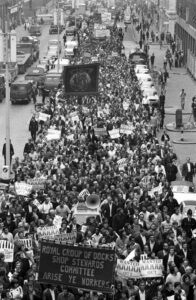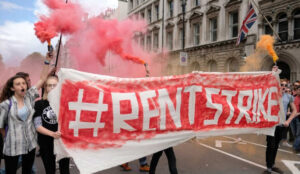 Direct action is about forcing things to change. We make it too expensive for bosses and landlords to refuse our demands. It works because they are in it to make a profit. Hit that profit, and you have them on the ropes. How do we actually do it? There’ll be a list of tactics in a moment. But first, you need a plan…
Direct action is about forcing things to change. We make it too expensive for bosses and landlords to refuse our demands. It works because they are in it to make a profit. Hit that profit, and you have them on the ropes. How do we actually do it? There’ll be a list of tactics in a moment. But first, you need a plan…
To plan a dispute you need a list of demands and an idea what to do if they say no. Planning should include as many people as possible (so long as they can be relied on not to grass – no managers allowed!). You could hold a mass-meeting, or just speak to everyone one-on-one – it’s up to you. Once you have a plan you’ll need to hand over your demands. The best way to do it is a march on the boss. For a workplace dispute pick a time, stop whatever you are doing, go together to the boss and demand a meeting. Community campaigns can march on the office of a letting agent or politician. Explain your demands and why they matter to you. This should NOT be done by any one spokesperson. Refuse to speak to them alone. Instead, stick together and take turns to ALL say your piece. This level of organisation scares them, and stops them picking out any one “ringleader” to persecute. If they refuse to listen, just hand over your demands and walk away.
Give them a deadline to respond. Once that’s passed, start with a small action and build up from there. It really is that simple!
We don’t always have to go through with direct action. Bosses and landlords may cave to our demands before it gets that far, because they see that we have the power and there is nothing they can do about it. The important thing is to show we are ready to go all the way. Another thing they are looking for is persistence. Show them you are not going to go away AND that you will ramp up the action when needed, and most owners will fold. It’s the combination that matters – neither militancy nor persistence alone will win it. You need both.
 Some owners are stubborn and will loose money rather than give in. There are two reasons: either because they worry it will lead to more demands in future, or because their owning-class friends ask them to make an example of us, to stop our direct action inspiring other people. In the first case, we just have to escalate even further. Forced to choose between negotiating or losing their business altogether, they will sit down and negotiate. The second case is more difficult. It’s rare but it does happen. When it does, they will have help from other businesses and the government. So we need to do the same thing and get the wider workers’ movement on our side. It CAN still be won, but it’s a hard fight and you may have to take a loss if the outside support doesn’t show up. It sucks, but remember the vast majority of disputes never get to this point! When we use direct action, with persistent and careful escalation, it results in a win nearly every time.
Some owners are stubborn and will loose money rather than give in. There are two reasons: either because they worry it will lead to more demands in future, or because their owning-class friends ask them to make an example of us, to stop our direct action inspiring other people. In the first case, we just have to escalate even further. Forced to choose between negotiating or losing their business altogether, they will sit down and negotiate. The second case is more difficult. It’s rare but it does happen. When it does, they will have help from other businesses and the government. So we need to do the same thing and get the wider workers’ movement on our side. It CAN still be won, but it’s a hard fight and you may have to take a loss if the outside support doesn’t show up. It sucks, but remember the vast majority of disputes never get to this point! When we use direct action, with persistent and careful escalation, it results in a win nearly every time.
There are some tricks to stop owners getting stubborn. Give them a way out that saves face. Make them feel it’s not a total loss to accept your demands. Owners like to have a reason they gave in, that isn’t just “I was powerless and they gave me no choice”. So why not feed them one? Sometimes there is a legal or financial argument we can make. If not, try a moral argument for why your situation isn’t fair. It doesn’t have to be rock solid! And it would make no difference if it was. The point is to give them an excuse to agree your demands.
Speaking of demands, they will want to negotiate. So start with that in mind and ask for more than you expect to get. Think of it like haggling at a car boot sale. You go low, they go high, and then you meet in the middle, both feeling you got something out of it. Community campaigns can use big demands as a tactic. Ask for something that really scares them. Worried that you will mobilise more people and somehow pull it off, they will rush to the negotiating table to shut you down before it spreads! Purely defensive campaigns rarely work. If the owners’ worst case scenario is just going back to how things were, they will happily sit it out and hope you run out of steam. Always ask for something more.
It’s worth getting some training before you begin. In the UK, contact either the Solidarity Federation or the IWW, and ask about their Workplace Organiser Training. Or, read through the guides on the Libcom website – workplace organising; and community organising.
Anyway, that’s enough caution for now! Next up: the direct action tactics [1] our class has used to FIGHT disputes AND WIN
Comms Blockade
 In a communications blockade, we pick a time, and then get as many people as possible to call/email/message a company at once. Modern companies can’t function without communications and it doesn’t take many people to tie up their phone lines. This causes a loss in profit, and it’s annoying as hell. (So be extra polite to staff who aren’t responsible – they are not the target!) Anyone from the community can participate, reminding the owners they may loose customers if they ignore our demands. International solidarity helps too – when a small business gets messages from union branches all over the world, they sit up and take notice.
In a communications blockade, we pick a time, and then get as many people as possible to call/email/message a company at once. Modern companies can’t function without communications and it doesn’t take many people to tie up their phone lines. This causes a loss in profit, and it’s annoying as hell. (So be extra polite to staff who aren’t responsible – they are not the target!) Anyone from the community can participate, reminding the owners they may loose customers if they ignore our demands. International solidarity helps too – when a small business gets messages from union branches all over the world, they sit up and take notice.
On social media this can escalate to reputation damage. Most companies have a profile where we can leave public reviews. Too many negative reviews, and they loose business.
The comms blockade is a good tactic for small demands. The Solidarity Federation uses it all the time to get back stolen deposits from landlords or unpaid wages from bosses.
Go Slow and Work to Rule
In a go slow, people work as slowly as possible. This may be safer than a full-on strike. On the other hand strikes are more visible – it’s easier to get everyone involved when they can see a picket line and see that no-one has gone into work.
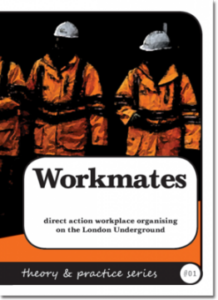 The safest way to do it is a work to rule. If we follow the rules of our workplace to the letter, refusing any work that isn’t in our contract, many companies grind to a halt. They depend on our good will and unpaid overtime and cutting corners. They also depend on our skills without realising – many companies only function at all because we ignore clueless managers and get on with the work that actually needs doing. During a work to rule, that cooperation ends. The most famous example is the “piss strike” taken by London Underground workers in the late 1990s. A Solidarity Federation member explains…
The safest way to do it is a work to rule. If we follow the rules of our workplace to the letter, refusing any work that isn’t in our contract, many companies grind to a halt. They depend on our good will and unpaid overtime and cutting corners. They also depend on our skills without realising – many companies only function at all because we ignore clueless managers and get on with the work that actually needs doing. During a work to rule, that cooperation ends. The most famous example is the “piss strike” taken by London Underground workers in the late 1990s. A Solidarity Federation member explains…
“One of the health and safety regulations stated that on the tracks, all workers must at all times be accompanied by a ‘Protection Master’- a member of the workforce trained to provide safety from trains and traction current. This meant each gang tended to have just the one Protection Master, as management didn’t want to waste money training up any more than they had to […]
“The toilet could be a good distance from the actual point of work out on the tracks, which meant a long walk. Of course they had to be accompanied by the Protection Master. This then left the rest of the gang without protection, so they’d have to come along too. The whole gang would therefore traipse to the toilet and back, only to return and have someone else realise they ‘needed’ to go too!
“The piss strike proved remarkably effective, with very little work getting done. Alongside the other work-to-rules, this had almost the effectiveness of a strike – but without the loss of pay and without the risk of being sacked for taking unofficial action in breach of contract. It forced management to completely cave in within two days, and the attempt to end the job-and-knock system was shelved” – from Workmates: direct action workplace organising on the London Underground
Strikes
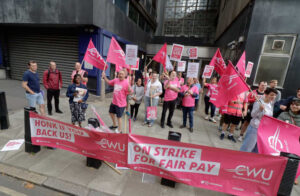 Strikes are the one direct action tactic that everybody’s heard of. Workers walk out, make demands, and set up a picket line to discourage other workmates from going in. The strikes we hear most about today are organised by official trade unions, who notify the company several months in advance, and only after a complicated vote and negotiations do people stop work for the day (or sometimes longer). The union leaders handle all negotiations, and sometimes win a lot of concessions. Too many times they have sent their members back to work without winning much at all.
Strikes are the one direct action tactic that everybody’s heard of. Workers walk out, make demands, and set up a picket line to discourage other workmates from going in. The strikes we hear most about today are organised by official trade unions, who notify the company several months in advance, and only after a complicated vote and negotiations do people stop work for the day (or sometimes longer). The union leaders handle all negotiations, and sometimes win a lot of concessions. Too many times they have sent their members back to work without winning much at all.
Now, let’s not knock official strikes – people have won a LOT of improvements this way. [2] But they aren’t the only way to do things. When we go on strike without official union permission, that’s a wildcat strike. In the old days of trade unionism, wildcat strikes were more common than the official ones. They were effective too. Often, negotiations were handled by a strike committee, elected from the workers themselves, and a mass meeting of all strikers would decide when to return to work – no officials to get in the way. Official or not, strikes should only be ended by a vote, not on the whim of union leadership.
In one case from the old days, a man almost caused a strike just by going to a doctors appointment! At that time the rule in the workers’ movement was “one out, all out”. So when his workmates saw him go for his coat, they thought he was walking out and all got up to join him. That’s the kind of fighting attitude we need to get back to.
The most effective wildcat is the lightning strike. This is where workers stop work without any notice at all. The law in the UK is that unions can be sued for doing this, so lightning strikes are always unofficial. Without any time to prepare, this hits the bosses a lot harder. There’s no time for them to hire new workers to break the strike. Since lightning strikes tend to win faster, people don’t go so long without pay.
The French Cooks Syndicate in London was a union that used only lightning strikes, mostly by kitchen staff and waiters. In the few years they existed, they had 38 strikes. They won every single strike. Not one worker was injured, arrested, or sacked. That’s the power of the lightning strike. Here’s what one of their members, Wilf McCartney, wrote in his book Dare to be a Daniel:
At 7:15 all dinners were being served with something, when suddenly a waiter clapped his hands and every member of the staff stopped work. The waiter looked for the manager. The poor man was nearly mad – he rushed up and down, but the waiter handed him our demands, exactly as on the last occasion. He refused, he hesitated, he read, he signed
Another clever tactic is the selective strike. When a whole company goes on strike, everyone loses wages. But at big employers, you don’t need a full-blown strike to stop production. This tactic was started by workers in Italy, who had rolling actions where one department walked out one day, and another department walked out the next. Since most staff went into work, they had to be paid even though no work was possible that day.
 Rules about sick pay or health and safety can be used to strike. In 2006 100 pilots in Norway staged a sick-in, in solidarity with other pilots on strike – the law at the time meant they could take 8 days sick leave without a doctors note. [3] In the UK, section 44 of the Employment Rights Act 1996 gives us the right to walk out of any workplace we “reasonably believe” unsafe. So long as we remain “available for work” – for example waiting in the canteen or car park – and so long as the danger is “serious and imminent”, they still have to pay wages. We should be ready for employers to ignore the law and fire us anyway. But it’s a lot safer than a usual wildcat strike, and that will encourage less confident workmates to join in.
Rules about sick pay or health and safety can be used to strike. In 2006 100 pilots in Norway staged a sick-in, in solidarity with other pilots on strike – the law at the time meant they could take 8 days sick leave without a doctors note. [3] In the UK, section 44 of the Employment Rights Act 1996 gives us the right to walk out of any workplace we “reasonably believe” unsafe. So long as we remain “available for work” – for example waiting in the canteen or car park – and so long as the danger is “serious and imminent”, they still have to pay wages. We should be ready for employers to ignore the law and fire us anyway. But it’s a lot safer than a usual wildcat strike, and that will encourage less confident workmates to join in.
There is also the sympathy strike, or “secondary action”. This is where a strike spreads, and other workplaces take action in support. That might just mean walking out themselves, adding to the pressure, or it might be more specific: posties refusing to deliver mail to the company in dispute, power workers disconnecting their electric. In a long strike this can be the difference between victory and defeat. The trouble is, just like the lightning strike, official unions can’t support it without getting sued. That shouldn’t stop us organising sympathy strikes without them. So long as we are determined enough, employers can’t fire us as they will just face more strikes in response.
In 1972 the government had five dockers arrested for taking illegal strike action (known as the Pentonville Five). But more strikes broke out all over the UK. Workers began to plan a general strike that would shut down every workplace in the country. That was too much for the government: all five men were released. [4] Solidarity like this is where our real power lies, not legal protections. As the campaign for the Pentonville Five shows, strikes aren’t limited to demands about wages and conditions in the workplace. They can win social and political demands as well. A strike with social demands is called a social strike.Strikes show the bosses that they need us. We could get by just fine without the owning class, but without the working class everything they own goes to pieces. That’s one reason strikes are the best-known tactic in the workers’ movement. But it doesn’t mean they’re always the best tool for the job. Remember: diversity is strength, and it’s always good to take the owners by surprise!
Good Work Strike
 In a good work strike instead of working less, we find our own way to do the job. We might continue working as usual but refuse to charge customers any money. Or we might work to such a high standard and take so long that no profit is made. This isn’t easy to pull off. Any official union who did this in the UK would be sued to hell and back, so it has to be organised quietly. Everyone must be prepared for legal threats and intimidation. If the bosses make an example of even one worker, the strike could collapse with everyone thinking “will I be next?”. The workforce has to be solid and defend every single worker from victimisation.
In a good work strike instead of working less, we find our own way to do the job. We might continue working as usual but refuse to charge customers any money. Or we might work to such a high standard and take so long that no profit is made. This isn’t easy to pull off. Any official union who did this in the UK would be sued to hell and back, so it has to be organised quietly. Everyone must be prepared for legal threats and intimidation. If the bosses make an example of even one worker, the strike could collapse with everyone thinking “will I be next?”. The workforce has to be solid and defend every single worker from victimisation.
That said, transport workers the world over have used the good work strike and won. As a public service other workers depend on, it’s better to keep buses and trains running if we can help it. But that doesn’t mean the owners have to make a profit!
“Lisbon bus and train workers gave free rides to all passengers today. They were protesting because the British-owned Lisbon Tramways Company had not raised their wages. Today conductors and tram drivers arrived at work as usual, but the conductors did not pick up their money satchels. On the whole the public seems to be on the side of these take-no-fare strikers and schoolboys are having the time of their lives. Holidays have begun, and they are hoping rides to pass the time” – The Times, July 2nd 1968
The same thing happened in Brisbane, Australia in the summer of 2017, and again in Okayama, Japan in the spring of 2018. [5]
Boycott
The word “boycott” comes from the actions of the Irish Land League in the 19th Century. The League was the poor peasants defence against the landlord. When a landlord evicted a tenant farmer the League applied its boycott against the new tenant and the landlord. Domestic servants left their houses, their labourers their fields and cattle, the grocer, the butcher, and even the doctor refused to serve them. It became a powerful weapon for peasants’ rights.
 Boycott nowadays is more about not buying from a company than not selling. The most famous example within England is probably the Bristol bus boycott. In 1963, the bus company in Bristol had a “colour bar”. With the shameful collaboration of the transport workers’ union, this meant black workers were not allowed to drive buses in Bristol. A campaign from the West Indian community lead to a boycott of the buses, with thousands of people refusing to ride. By September of that year both the company and the union gave in, and the first non-white bus conductor in Bristol started work. [6] So long as it is part of a well-organised campaign(and not a random call with no follow-up), a boycott can still be a powerful weapon in the hands of a community.
Boycott nowadays is more about not buying from a company than not selling. The most famous example within England is probably the Bristol bus boycott. In 1963, the bus company in Bristol had a “colour bar”. With the shameful collaboration of the transport workers’ union, this meant black workers were not allowed to drive buses in Bristol. A campaign from the West Indian community lead to a boycott of the buses, with thousands of people refusing to ride. By September of that year both the company and the union gave in, and the first non-white bus conductor in Bristol started work. [6] So long as it is part of a well-organised campaign(and not a random call with no follow-up), a boycott can still be a powerful weapon in the hands of a community.
Community Pickets
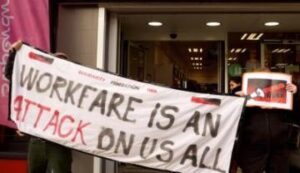 In a strike, pickets persuade other workers not to work (or physically stop them). We can also use community pickets to hit the profits of a business by keeping out their customers. This works best on companies that own shops on the high-street. The International Workers’ Association use community pickets to support workplace disputes. It’s one thing for bosses in a transnational corporation to face demands from a few local workers. It’s another when they have managers from half way across the world complaining that protesters turned all their customers away!
In a strike, pickets persuade other workers not to work (or physically stop them). We can also use community pickets to hit the profits of a business by keeping out their customers. This works best on companies that own shops on the high-street. The International Workers’ Association use community pickets to support workplace disputes. It’s one thing for bosses in a transnational corporation to face demands from a few local workers. It’s another when they have managers from half way across the world complaining that protesters turned all their customers away!
Community pickets were also the main tool in the fight against workfare in the 2010s. Workfare was a scheme by the UK government to force benefit claimants to work for free – which was misery for them, and undercut the wages of paid workers as well. The campaign against it was organised by several groups, including Boycott Workfare, Bristol Anarchist Federation, Disabled People Against the Cuts, and The Solidarity Federation. By targeting the stores of one company at a time with community pickets, they forced them to drop out one-by-one until the whole scheme collapsed. Workfare was a big part of government plans for austerity, planned by the Labour Party after the 2008 financial crisis and then put into action by the Conservatives. Without community pickets we’d still be facing workfare today. [7]
Rent Strikes and Non-Payment
A rent strike is simple – we just stop paying rent until landlords meet our demands. The Glasgow Rent Strike of 1915 was the largest in the UK so far, organised by Glasgow Women’s Housing Association. 20,000 tenants stopped paying rent across the city, and fought off all bailiffs sent to evict them. [8] More rent strikes and protests broke out elsewhere in support. In the end, not only did the Glasgow women stop the rent hike, they forced the government to bring in rent controls and in 1919 state provision of housing was made a human right.
Rent strikes still happen today – we saw a wave of student rent strikes during the pandemic. All over the UK, the campaigns won significant reductions in rent. [9]
Rent strikes aren’t the only kind of non-payment. The biggest of all was the poll tax rebellion of 1989-1991. Mobilised by Poll Tax Unions in every town and neighbourhood in the UK, 17 million people refused to pay the tax. People continued to refuse even when threatened with prison, and organised to defend themselves from bailiffs sent to collect the tax by force. One protest in London turned into the notorious Poll Tax Riot. Before long, the tax was abolished and prime minister Margaret Thatcher was forced to resign. To this day, the government has never tried to bring back such an unfair tax. [10]
Blockades
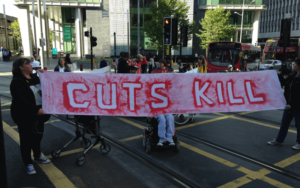 Blockades mean blocking infrastructure, like businesses or roads, to stop it from working. That does mean we have to make sure it isn’t hurting ordinary people more than the owning class. If it’s not successful then a lot of people could be disrupted for no reason at all, so we have to do it carefully. [11]
Blockades mean blocking infrastructure, like businesses or roads, to stop it from working. That does mean we have to make sure it isn’t hurting ordinary people more than the owning class. If it’s not successful then a lot of people could be disrupted for no reason at all, so we have to do it carefully. [11]
In the 1990s, disabled people in the Direct Action Network blocked roads, particularly buses which wheelchair users were not allowed to ride at the time. They were the militant wing of the wider disability movement, which altogether had about 200,000 people involved in grassroots groups, united in the British Council of Organisations of Disabled People. [12] The blockades and other protests are why we got the Disability Discrimination Act and more rights for disabled workers. [13]
 The No Borders movement use targeted blockades to stop refugees from being deported, even to the point of blocking the runway of an airport. Many people have since won the right to stay in the UK, sometimes just hours after their flight would have already left were it not for a blockade. The Anti-Raids Network does the same kind of thing, blocking Immigration Enforcement from taking people in the first place. Whole streets have got involved to protect their neighbours!
The No Borders movement use targeted blockades to stop refugees from being deported, even to the point of blocking the runway of an airport. Many people have since won the right to stay in the UK, sometimes just hours after their flight would have already left were it not for a blockade. The Anti-Raids Network does the same kind of thing, blocking Immigration Enforcement from taking people in the first place. Whole streets have got involved to protect their neighbours!
Blockades haven’t been used much by the UK anti-austerity movement, beyond a few protests by Disabled People Against the Cuts. But they played a big role overseas. Anti-austerity protests in 2019 in Ecuador, mostly by indigenous activists, also involved massive blockades – some of which turned into riots when police attacked. After the blockades got so big they effectively shut down the whole country, the government gave in and reversed austerity measures. [14] After a decade of mostly peaceful protests against austerity in the UK, blockades might be a good way to escalate?
Sit-ins and Occupations
 Instead of walking out or blockading – we can also cause problems by refusing to leave! That’s what sit-ins and occupations are all about. It’s a bit arbitrary to distinguish between the two. A sit-in usually means something more passive and short-lived, whereas occupation implies positive action actually to take over a workplace and to deny access to the management. There used to be quite a few sit-ins in the UK workplaces, and they’re just now coming back into fashion.
Instead of walking out or blockading – we can also cause problems by refusing to leave! That’s what sit-ins and occupations are all about. It’s a bit arbitrary to distinguish between the two. A sit-in usually means something more passive and short-lived, whereas occupation implies positive action actually to take over a workplace and to deny access to the management. There used to be quite a few sit-ins in the UK workplaces, and they’re just now coming back into fashion.
In the 2010’s, claimants’ unions used sit-ins to win disputes. Usually this was on behalf of individual benefit claimants, for example when jobcentres stopped activists from accompanying people to their appointments.Accompaniment is essential to stop the jobcentres from bullying vulnerable claimants. A few hours of activists refusing to leave will usually cause enough chaos to force management to give in – much quicker than waiting months or years for an official complaint to go through! Security are prepared for individuals kicking off, but not for a whole group of us to quietly sit down and refuse to leave.
After the 2008 financial crisis a lot of jobs got more precarious – as always our class is asked to pay for the owners’ mistakes. In 2009 this happened to the workers at Visteon, a company set up by Ford. Ford sacked all the workers at Visteon, refusing to pay wages and benefits on a technicality. They couldn’t exactly go on strike after their factories had shut down, so they had to get creative. Workers in Belfast occupied their factory first, followed by Basildon and then Enfield soon after. Unions and supporters both local, national, and even international mobilised in solidarity. After weeks of refusing to leave their former workplace, they forced Ford to give in and pay the people made redundant. [15]
Occupations don’t have to shut down the workplace. In some places they have escalated to a full on takeover by workers, running things for themselves. This is exactly what happened in Italy during the stay-in strikes of 1920 – read more about it here. Other times, as in the recent Amazon sit-ins in the UK, they were just the simplest way to go on strike. There are advantages: for one it’s easier to assemble in a cafeteria or shop floor, than outside in the car park. For another, staying in makes it harder for a company to bring in people to scab on the strike.
Eviction Resistance
 The ultimate weapon of any tenants union, occupation, or squat is eviction resistance. When a landlord goes to evict a tenant or squatter, they have to get a court order. [16] Once that’s signed off, they send in the bailiffs to break down the doors and drag the tenants out. Usually it starts with a quiet approach during waking hours, and if that doesn’t work: build up to sledgehammers and locksmiths at dawn. If the occupiers are lucky then they will be able to go back later to collect their possessions. If they are unlucky then the bailiffs will wreck the place and claim it was like that when they got there. This is the violence behind their property ownership and their profits.
The ultimate weapon of any tenants union, occupation, or squat is eviction resistance. When a landlord goes to evict a tenant or squatter, they have to get a court order. [16] Once that’s signed off, they send in the bailiffs to break down the doors and drag the tenants out. Usually it starts with a quiet approach during waking hours, and if that doesn’t work: build up to sledgehammers and locksmiths at dawn. If the occupiers are lucky then they will be able to go back later to collect their possessions. If they are unlucky then the bailiffs will wreck the place and claim it was like that when they got there. This is the violence behind their property ownership and their profits.
But communities can fight back. That might mean peacefully surrounding the house to blocking bailiffs from getting in. This won’t hold them off for long, but gets the landlord bad press and slows them down a bit. On the other hand it can escalate. Activists have turned up to evictions in masks and fought police and bailiffs, while doors were barricaded and rooftops occupied (always take the roof! It’s the hardest place to remove you from). [17] [18]
It’s difficult to stop an eviction forever. After months under siege it’s hard to keep the resistance alive. Most attempts end with people either thrown out, or choosing to leave. It’s still worthwhile. Resistance can force landlords and local councils to negotiate, because it costs them money. [19] And even better, it slows everything down. At the time of writing we are in a cost of living crisis and thousands of people are falling behind on rent and bills. If every person resisted eviction, even a small token resistance, there is no way they could get around to removing us all. Each delay slows down the system for everyone, giving the rest longer to find a new place or live rent-free in the meantime. Arrests can be avoided so long as people take sensible precautions such as wearing masks and only hitting back when the police are outnumbered. In cities where a strong squatter movement has taken hold, eviction delays have gone from weeks to many months because of community resistance. And these are just closed communities of squatters. Imagine what it’d be like if whole neighbourhoods got involved?
Informal Resistance
 Not every action has demands – sometimes the best way to improve conditions is to just go ahead and do it for ourselves. At one warehouse, workers took it in turns to sleep on shift while the others kept an eye out for management. The company never found out, so they all took turns getting paid to sleep! [20] There are little rebellions like this happening everywhere. Small acts of sabotage by people who resent being forced to work. Sometimes people act alone, sometimes together.
Not every action has demands – sometimes the best way to improve conditions is to just go ahead and do it for ourselves. At one warehouse, workers took it in turns to sleep on shift while the others kept an eye out for management. The company never found out, so they all took turns getting paid to sleep! [20] There are little rebellions like this happening everywhere. Small acts of sabotage by people who resent being forced to work. Sometimes people act alone, sometimes together.
The way managers put a stop to informal resistance is by making us feel “involved” in production. That might mean acting friendly and inserting themselves into our social groups. It might mean making teams “self managed” (but who signs off on holiday leave and sick days? The managers still keep control of that!). Most companies try to get us to identify with them and feel proud of their brand. To counter this, we need to have a culture of resistance. Encourage workmates to distrust the people in charge, socialise after work without managers present, and sort out problems between ourselves without grassing on each other. This takes time and you have to befriend and include every new worker if you want to pull it off.
One Solidarity Federation members recalls:
“I remember explaining to a guy, he’d done a really good job, but if he worked so hard then management would expect it of us every time. He looked so disappointed at the cynicism, I felt guilty. But the guy he’d replaced lost sight in one eye due to stress – keeping the work rate down was for his own good and the good of all of us.”
Self Help
 The UK government response to Covid-19 was shocking. They took too long to respond, a lot of disabled people were left behind or forgotten about, and there were allegations their official scientific advisors were corrupt. A lot of people died, and are still dying, while a few rich people actually made money off it. But some of this was made up for, by the fantastic response from working class communities. Mutual-aid groups sprung up all over the UK, providing free food and help to vulnerable people who had to isolate. At its height there were 4,300 of these groups. [21] Trade unions funded an independent group of scientists to report on the pandemic and hold the government to account. When the government tried to force schools to re-open at the height of the pandemic, teachers threatened a strike. They made their own lockdown, saving lives and saving thousands of kids from getting infected.
The UK government response to Covid-19 was shocking. They took too long to respond, a lot of disabled people were left behind or forgotten about, and there were allegations their official scientific advisors were corrupt. A lot of people died, and are still dying, while a few rich people actually made money off it. But some of this was made up for, by the fantastic response from working class communities. Mutual-aid groups sprung up all over the UK, providing free food and help to vulnerable people who had to isolate. At its height there were 4,300 of these groups. [21] Trade unions funded an independent group of scientists to report on the pandemic and hold the government to account. When the government tried to force schools to re-open at the height of the pandemic, teachers threatened a strike. They made their own lockdown, saving lives and saving thousands of kids from getting infected.
This can’t be our solution to every problem – because the rich have hoarded so many resources to themselves, there is not enough time in the day for volunteering to make up for it. [22] At some point we have to start taking stuff back from them. But in a limited way, whether that’s crisis response, or charity volunteering, or food banks, or mutual aid: self-help is one kind of direct action that we can use to keep our communities alive. [23]
?????
For every single one of these tactics, someone had to be the first to think it up and take action. There is a first time for everything. So be creative! There were a few left out here because they have only been used a few times, and it’s good to take the bosses by surprise. We need to keep the owning class on their toes, by always trying new ways to fight back!
Conclusion
So there you have it. This article is part of a series on the class struggle. The previous article was WHY WE FIGHT THE CLASS WAR. Next fortnight, look out for CLASS AND OPPRESSION – AN INJURY TO ONE IS AN INJURY TO ALL. Same time, same place!
Footnotes:
[1] – This list of tactics is based off the one in Trade Unionism or Syndicalism, written in 1941 by Tom Brown of the Syndicalist Workers’ Federation (now the Solidarity Federation). It has been added to by several groups over the years. The Solidarity Group wrote an updated version in 1971, and the Seattle IWW adapted that in 1974 as “a workers’ guide to direct action”. The Direct Action Movement (now the Solidarity Federation) did a version in the 1980s – Direct Action in Industry. We are proud to carry on the tradition and have updated it with some newer examples. For the first time, community action is included. Combining community and workplace organising is something syndicalists have done for quite some time, but until now our writing has not kept up with our actions!
[2] – for more on how official strikes work and how to make them good, see the STRIKE pamphlet by the Solidarity Federation – https://www.thesparrowsnest.org.uk/collections/public_archive/12815.pdf
[3] – https://libcom.org/article/scandinavian-pilots-wildcat-stoppage-spreads
[4] – https://libcom.org/article/how-kill-act-parliament-jack-ray; https://www.fbu.org.uk/magazine/august-september-2022/pentonville-five-arise-ye-workers
[5] – sources: https://www.triplem.com.au/story/union-bus-drivers-refusing-to-take-fares-today-as-strike-action-heats-up-46730; https://japantoday.com/category/national/okayama-buses-strike-by-continuing-to-run-and-refusing-to-take-anyone%E2%80%99s-money
[7] – for more information on the campaign and backstory, see http://solfed.org.uk/plymouth/why-the-abuse-of-benefits-claimants-is-hurting-all-workers
[8] – https://libcom.org/article/defending-our-homes-against-landlord-tyranny-rent-strikes-then-and-now
[9] – https://web.archive.org/web/20220329204809/http://www.rent-strike.org/
[10] – for a full account of the movement against the Poll Tax, see Poll Tax Rebellion by Danny Burns – https://libcom.org/article/poll-tax-rebellion-danny-burns
[11] – The two biggest recent blockades in the UK are controversial. First in the year 2000 was the protests against fuel prices and government taxes on fuel. People held up motorways by driving so slowly they caused huge tailbacks. Other action was more targeted. The small number of oil refineries and ports used to supply the whole of the UK makes it very easy to shut down the industry with just a few people. There is a helpful map of oil refineries available here: https://www.concawe.eu/refineries-map. In the end, this action worked and there was a freeze on fuel duties. However there were rumours that this only happened due to oil companies covertly encouraging the protests from the start. The other example is the recent (2020s) climate protests, in particular Insulate Britain. Small teams blocked strategically selected small roads, which cause tailbacks onto the motorways themselves to the point that all traffic ground to a halt. While they have caused massive disruption, they have also seen a lot more public anger compared to the fuel price protests, and they haven’t yet won any of their demands.
[12] – Colin Barnes, The Disabled People’s Movement and its Future, Ars Vivendi Journal No. 5 (August 2013)
[13] – https://www.bbc.co.uk/news/explainers-54823810
[15] – for more information on the Ford-Visteon occupation, see: https://libcom.org/tags/visteon-occupation
[16] – for more on the process, see the Squatters’ Handbook published by the Advisory Service for Squatters – https://network23.org/ass/squatters-handbook/
[17] – the Student Organisers’ Handbook has some advice on resisting the eviction of an occupation: https://studenthandbook.ourproject.org/book/c4.html#the-end
[18] – the successful resistance in Avonmouth, which ended when the council backed down and offered the tenant a new home, used a roof platform. Seen here – https://thebristolcable.org/2016/06/council-face-barricades-and-fail-to-evict-avonmouth-protesters/
[19] – for example see the story of 44 Richmond Terrace in Avonmouth, as told by The Bristolian – https://thebristolian.net/tag/44-richmond-terrace/
[21] – https://blogs.lse.ac.uk/covid19/2021/05/06/where-next-for-britains-4300-mutual-aid-groups/
[22] – for a broader critique of the modern “mutual aid” movement, see – https://theanarchistlibrary.org/library/black-flag-sydney-socialism-is-not-charity-why-we-re-against-mutual-aid
[23] – for example, the excellent Black Panther Party Community Survival Programs explicitly acknowledged their self-help was about “survival pending revolution”, not the revolution itself. Learn more about them here – https://bppaln.org/programs

